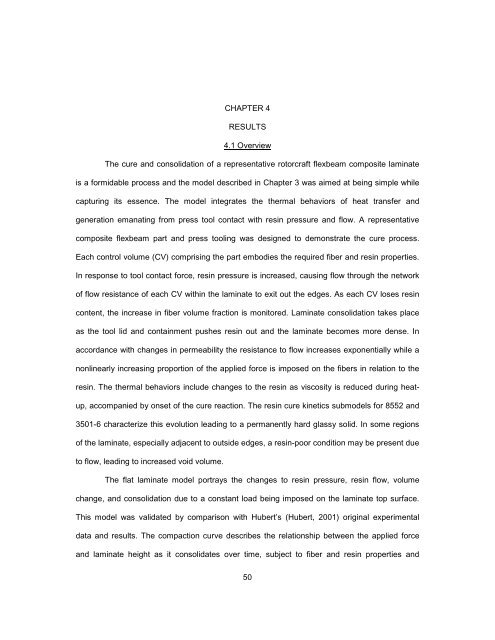TOOLED THICK COMPOSITES by ARVEN H. SAUNDERS III ...
TOOLED THICK COMPOSITES by ARVEN H. SAUNDERS III ...
TOOLED THICK COMPOSITES by ARVEN H. SAUNDERS III ...
Create successful ePaper yourself
Turn your PDF publications into a flip-book with our unique Google optimized e-Paper software.
CHAPTER 4<br />
RESULTS<br />
4.1 Overview<br />
The cure and consolidation of a representative rotorcraft flexbeam composite laminate<br />
is a formidable process and the model described in Chapter 3 was aimed at being simple while<br />
capturing its essence. The model integrates the thermal behaviors of heat transfer and<br />
generation emanating from press tool contact with resin pressure and flow. A representative<br />
composite flexbeam part and press tooling was designed to demonstrate the cure process.<br />
Each control volume (CV) comprising the part embodies the required fiber and resin properties.<br />
In response to tool contact force, resin pressure is increased, causing flow through the network<br />
of flow resistance of each CV within the laminate to exit out the edges. As each CV loses resin<br />
content, the increase in fiber volume fraction is monitored. Laminate consolidation takes place<br />
as the tool lid and containment pushes resin out and the laminate becomes more dense. In<br />
accordance with changes in permeability the resistance to flow increases exponentially while a<br />
nonlinearly increasing proportion of the applied force is imposed on the fibers in relation to the<br />
resin. The thermal behaviors include changes to the resin as viscosity is reduced during heat-<br />
up, accompanied <strong>by</strong> onset of the cure reaction. The resin cure kinetics submodels for 8552 and<br />
3501-6 characterize this evolution leading to a permanently hard glassy solid. In some regions<br />
of the laminate, especially adjacent to outside edges, a resin-poor condition may be present due<br />
to flow, leading to increased void volume.<br />
The flat laminate model portrays the changes to resin pressure, resin flow, volume<br />
change, and consolidation due to a constant load being imposed on the laminate top surface.<br />
This model was validated <strong>by</strong> comparison with Hubert’s (Hubert, 2001) original experimental<br />
data and results. The compaction curve describes the relationship between the applied force<br />
and laminate height as it consolidates over time, subject to fiber and resin properties and<br />
50
















